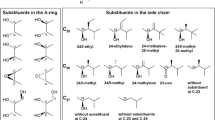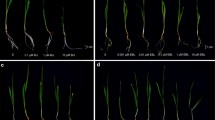Abstract
Brassinosteroids are of ubiquitous occurrence in plants and elicit a wide spectrum of physiological responses. In our study, brassinosteroids were isolated and identified in topmost dormant leaves of tea plants. Six brassinosteriods, i.e. 6-deoxocastasterone, 24-epibrassinolide,3-dehydroteasterone, typhasterol, 3-deoxotyphasterol and 28-homodolicholide, were isolated and identified by GC–MS. All the brassinosteroids identified belong to important components of early and late C6 oxidation pathways proposed for brassinosteroids biosynthesis in plants. It suggests that both pathways are operating in tea to produce brassinolide, the most active brassinosteroid biologically.
Similar content being viewed by others
References
Abe H., Morishita T., Uchiyama M., Takatsuto S. and Ikekawa N. 1984. A new Brassinolide-related steroid in leaves of Thea sinensis. Agric. Biol. Chem. 48(8): 2171–2172.
Alexeeva K.L., Malevannaya N.N., Khripach V.A. and Zhabinskii V.N. 1999. A method of growth stimulation of meadow mushrooms. Pat. Appl. RU99 106: 737.
Altmann T. 1999. Molecular physiology of brassinosteroids revealved by the analysis of mutants. Planta 208: 1–8.
Barua D.N. 1989. Science and Practice in Tea Culture. Tea Research Association, Tocklai Experimental Station, Jorhat, Assam.
Clouse S.D. 1997. Molecular genetic studies confirm the role of brassinosteroids in plant growth and development. Annu. Rev. Plant Physiol. Plant Mol. Biol. 49: 427–451.
Clouse S.D., Langford M. and McMoris T.C. 1996. A brassinosteroid-insensitive mutant in Arabiodopsis thaliana. Proc. Plant Growth Regul. Soc. Am. 23: 14.
Clouse S.D. and Sasse J.M. 1998. Brassinosteroids. Nat. Prod. Rep. 14: 1–10.
Dhaubhadel S., Chaudhary S., Dobinsen K.F. and Krishna P. 1999. Treatment with 24-epibrassinolide, a brassinosteroid, increases the basic thermotolerance of Brassica napus and tomato seedlings. Plant Mol. Biol. 42: 333–342.
Fujioka S., Noguchi T., Takatsuto S. and Yoshida S. 1998. Brassinosteroids in Arabiodopsis thaliana. Phytochemistry 48: 595–599.
Khripach V., Zhabinskii V. and deGroot A. 1999. Twenty years of Brassinosteroids: steroidal plant hormones Warrant Better Crops for the XXI Century. Ann. Bot. 86: 441–447.
Khripach V., Zhabinskii V. and deGroot A. 2000. Brassinosteroids: A New Class of Plant Hormones. Academic Press, London.
Li J. and Chory J. 1999. Brassinosteroid action in plants. J. Exp. Bot. 50: 275–282.
Mayumi K. and Shibaoka H. 1995. A possible double role for brassinolide in the reorientation of cortical microtubules in the epidermal cells of Azuki bean epicotyl. Plant Cell Physiol. 36: 173–181.
Nagar P.K. 1996. Changes in endogenous abcisic acid and phenols during winter dormancy in tea (Camellia sinensis (L.) O.Kuntz). Acta Physiol. Plant 18: 33–38.
Nandi S.K., Palni L.M.S. and Rashmi 1995. Chemical manipulation of dormancy in tea shoots and associated biochemical changes. J. Plant Crops 23: 52–58.
Nagar P.K. and Kumar A. 2000. Changes in endogenous gibberellins during winter dormancy in tea. Acta Physiol. Plant 22: 45–49.
Noguchi T., Fujioka S., Choe S., Takatsuto S., Tax F.E., Yoshida S. and Feldmann K.A. 2000. Biosynthetic pathways of barssinosteroids in Arabidopsis. Plant Physiol.124: 201–209.
Pursakova L.D. and Chizhova S.I. 1996. The role of brassinosteroids in growth, tolerance and productivity in plants. Agrokhimiya 137–150.
Runkova L.V., Alexandrova V.S. and Belyaeva G.C. 1999. The actions of epin on taking roots of prespective varieties of roses. In: Shevelucha V.S., Karsunkina N.P., Salnikova E.I., korobgatova I.V. and Siusheva A.G. (eds), Regulators of Plant Growth and Developments. Agricultural Academy, Moscow, pp. 245–246.
Steber C.M. and McCourt P. 2000. A role of brassinosteroids in germination in Arabidopsis. Plant Physiol. 25: 763–769.
Sakurai A. and Fujioka S. 1993. The current status of physiology and biochemistry of brassinosteroids. Plant Growth Regul. 13: 147–159.
Sakurai A. and Fujioka S. 1997. Studies on biosynthesis of brassinosteroids. Biosci. Biotech. Biochem. 61: 757–762.
Takatsuto S., Yazawa N., Ikakawa N. Takemaatsu T., Takeuchi Y. and Koguchi M. 1983. Structure-activity relationtionship of brassinosteroids. Phytochemistry 22: 2437–2441.
Author information
Authors and Affiliations
Rights and permissions
About this article
Cite this article
Gupta, D., Bhardwaj, R., Nagar, P. et al. Isolation and Characterization of Brassinosteroids from Leaves of Camellia sinensis (L.) O. Kuntze. Plant Growth Regulation 43, 97–100 (2004). https://doi.org/10.1023/B:GROW.0000040118.68011.6a
Issue Date:
DOI: https://doi.org/10.1023/B:GROW.0000040118.68011.6a




